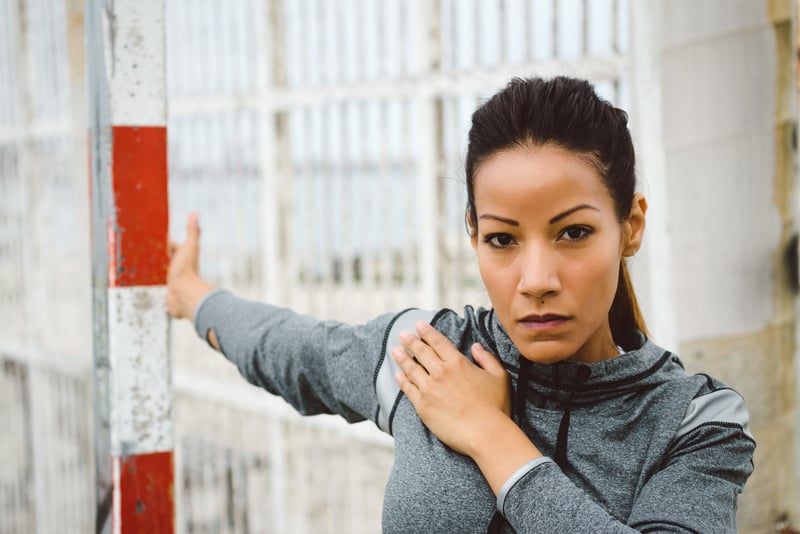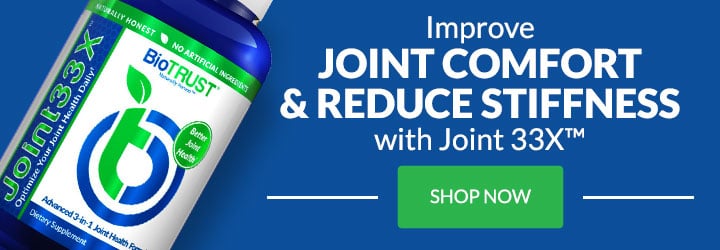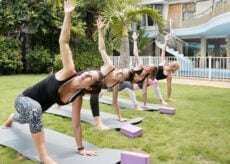These 5 Stretches Can Make You Look 10 Years Younger

According to the American College of Sports Medicine (ACSM), the health benefits of exercise and regular physical activity are “indisputable.” 1 Regular exercise and physical activity have beneficial effects on:
- Overall health
- Heart health
- Metabolic health
- Blood pressure
- Biomarkers of cardiovascular health
- Body composition
- Bone health
- Balance (preventing falls)
- Mood
- Energy levels
- Feelings of wellbeing
- Brain health and cognitive function
According to the National Institutes of Health (NIH), exercise and physical activity are good for just about everyone, especially as we age. No matter your health and physical abilities, you can gain a lot by staying active.
In fact, in most cases, you have more to lose by not being active. According to the NIH, regular exercise and physical activity: 2
- Can help maintain and improve your physical strength and fitness.
- Can help you improve your ability to do the everyday things you want to do.
- Can help improve your balance.
- Can help manage and improve overall, cardiovascular, metabolic, and bone health.
- Can help improve mood and feelings of well-being.
- May improve your ability to shift quickly between tasks, plan an activity, and ignore irrelevant information.
Clearly, exercise is incredibly important at any age, and it arguably becomes even more for disease prevention and healthy aging. 3 Simply put, exercise is key to healthy aging.
What Should an Exercise Program Include?
Traditionally, most have associated healthy aging with low- to moderate-intensity “cardio” types of exercise (e.g., walking). Endurance and cardiorespiratory fitness are most certainly fundamental pillars of a comprehensive exercise program. But there’s also been a paradigm shift based on the most recent findings from nutrition and exercise sciences.
Specifically, recent research has highlighted the metabolic and functional importance of focusing on “quality weight loss.” That is, decreasing body fat and abdominal obesity while maintaining or even increasing muscle mass. It’s also focused on how to efficiently and effectively increase cardio fitness and muscle strength.
In particular, recommendations for exercise are shifting to higher intensity, brief aerobic training (e.g., high-intensity interval training), resistance training (full-body workouts using multiple muscle groups), and structured physical activity (e.g., step counts). 3
While that’s certainly a step in the right direction, lifting weights and conditioning exercises are only part of the complete picture for optimal health. As the ACSM states, “A program of regular exercise that includes cardiorespiratory, resistance, flexibility, and neuromotor exercise training beyond activities of daily living to improve and maintain physical fitness and health is essential for most adults.” 1
The ACSM recommends that adults lift weights 2 – 3 days per week, including exercises for all major muscle groups, and neuromuscular exercises should be included in those workouts. Flexibility has been defined as the ability to move a joint or series of joints through a full, non-restricted, pain-free range of motion. Flexibility is dependent on a combination of: 4
- Joint range of motion, which may be limited by the shape of the joint and by structures that attach to that joint; and
- Muscle flexibility, or the ability of the unit to lengthen.
Generally speaking, stretching addresses the latter, addressing both passive and active muscle “tightness.” 5 As for flexibility training, there are several crucial variables to consider:
- Frequency. At least 2 – 3 days per week are effective in improving joint range of motion, with the greatest benefits coming from daily exercise.
- Intensity. Stretch to the point of feeling tightness or slight discomfort.
- Time. Holding a static stretch for 10 – 30 seconds is recommended for most adults. For older adults, holding a stretch for 30 – 60 seconds may offer greater benefits.
- Type. There are several different types of flexibility training, including static flexibility (the most common), dynamic flexibility, ballistic flexibility, and PNF, which are each effective. For this report, the focus will be on seven static stretches, used for increasing flexibility and range of motion.
- Volume. A reasonable target is to perform 60 seconds of total stretching time for each exercise.
- Pattern. Repetition of each flexibility exercise 2 – 4 times is recommended. For instance, you could perform 2 sets of 30-second static stretches or 4 sets of 15-second static stretches.
- Timing. Flexibility exercise is most effective when the muscles are warmed up through light or moderate aerobic activity or passively through external methods, such as moist heat packs or hot baths.
Stretching, particularly static stretching, can have a negative effect on subsequent strength and power performance. In other words, static stretching should not be performed before weight training.6
How Can Flexibility Exercise Make You Look and Feel Younger?
When people think about types of exercise to look and feel better and younger, the first tools that come to mind are endurance and resistance training, and rightfully so. Yet despite its obvious significance, flexibility is often overlooked. However, it plays a crucial role in overall health, fitness, and function.
Tight muscles can lead to joint and muscle discomfort, poor posture, and difficulty performing simple tasks, such as household chores, getting out of bed, and playing with your children or grandkids. Limited flexibility can lead to poor balance. While that’s an obvious concern for older folks who are worried about falling, balance also plays a vital role in sports performance and injury prevention.
Simply put, poor flexibility and limited mobility can make you look and feel old—even much older—by negatively affecting posture, limiting you from doing what you enjoy most, adversely affecting daily activities, negatively impacting quality of life, and increasing the likelihood of injuries, muscle soreness, and joint discomfort. Flexibility is the limiting factor of what you can do, how far you can go, and whether you may fall or be injured.
Unfortunately, flexibility and range of motion decrease with age—if you don’t work on them. The fortunate news is that flexibility can be improved across ALL age groups with proper flexibility training.
In fact, range of motion can be improved with as little as 4 weeks of regular stretching 2 – 3 times per week. With an even more intensive program (> 3 times per week), flexibility can improve in as few as 10 workouts.
In addition to increasing range of motion, flexibility exercises have been shown to improve functional capacity, posture, stability, balance, and quality of life. Some studies have shown that regular flexibility exercise can even reduce the likelihood of injuries, prevent low back pain, and reduce muscle soreness.
Taken together, when performed regularly and properly, flexibility exercise offers the following benefits:
- Better posture
- Increased range of motion
- Increased mobility
- Improved functional capacity
- Increased independence
- Improved balance
- Improved quality of life
- Improved self-confidence
- Reduced likelihood of injury
- Reduced likelihood of falling
- Reduced joint discomfort
- Reduced muscle soreness
In other words, a regular, well-designed flexibility training program can make you look and feel younger!
It’s important to note flexibility training is most effective when combined with strength training and neuromotor exercise, as these variables can enhance the effectiveness of a flexibility routine. And because flexibility training does not improve cardiorespiratory fitness, it should also be combined with the appropriate volume of endurance training. Flexibility exercise is just one (important) component of a general fitness program, and together, a well-rounded exercise program can combat the harmful effects of aging. 7
What Are the Most Important Stretches?
Speaking generally, it’s best to perform a series of exercises targeting all the major areas of the body:
- Shoulder girdle
- Chest
- Neck
- Trunk
- Lower back
- Hips
- Posterior and anterior legs
- Ankles
Having said that, when it comes to looking and feeling younger, the three key areas of the body that need to be addressed are:
- Hips
- Thoracic spine (upper back)
- Ankles
These three areas are huge hubs of motion, and dozens of muscles influence the motion of each. For instance, reduced hip and ankle range of motion can substantially limit your ability to perform basic movements like squatting to pick something or someone up.
Not only that, when hip mobility is sacrificed, the odds of low-back issues increase significantly, while poor ankle mobility can lead to knee, hip, shoulder, and even neck problems.
Meanwhile, reduced range of motion at the thoracic spine (where your ribs connect to the spine) can limit your ability to reach overhead and turn your head side to side. Not surprisingly, limited thoracic mobility can result in shoulder, neck, and elbow trouble. And if there’s a single telltale postural sign of getting older, it’s having a “hunchback,” which is an indication of poor thoracic spine extension.
5 Stretches to Look 10 Years Younger
Along those lines, what follows are our top stretches for looking and feeling your best.
As a reminder, for best results, stick to the following guidelines:
- Frequency. Perform the series of stretches at least 2 – 3 days per week; performing the routine more often may result in greater benefits.
- Intensity. Stretch to the point of feeling tightness or slight discomfort.
- Time. Hold each stretch for 15 – 30 seconds. For older adults, holding a stretch for 30 – 60 seconds may offer greater benefits.
- Volume. Perform at least 60 seconds of total stretching time for each exercise.
- Pattern. Perform each stretch 2 – 4 times to achieve the recommended volume:
- 2 sets of 30-second stretches.
- 3 sets of 20-second stretches.
- 4 sets of 15-second stretches.
- Timing. Warm-up with light or moderate aerobic activity or using passive methods (e.g., heat packs) before stretching. Do not perform stretching before resistance training.
Before starting any exercise program, you should consult with your physician or other healthcare professional to determine if it is right for you and your needs. Do not start a fitness program if your physician or healthcare provider advises against it. If you experience faintness, dizziness, pain, or shortness of breath at any time while performing exercise, please stop immediately.
Stretch #1: Kneeling Quad & Hip Flexor Stretch (Couch Stretch)
Target muscles: Anterior thighs, hip flexors
Instructions:
- Go into a lunge/kneeling position with your left foot forward and putting your right foot up on a bench, ottoman, etc., behind you.
- Your right hip, knee, and ankle should be aligned.
- Place your right hand on the floor next to your left foot for support.
- Activate your right glute and push your right hip forward. You should feel a stretch in the front of your right thigh and hip. Hold the stretch for 15 – 30 seconds.
- Then raise your torso and reach your right hand as high as you can straight up, followed by flexing laterally to the left. You should once again feel a stretch in the front of your right thigh and hip. Hold the stretch for 15 – 30 seconds.
- Repeat the series of stretches on the left side.
- Continue alternating between the right and left sides until you reach at least 60 seconds total of each of the stretches.

Stretch #2: Posterior Chain Sequence
Target muscles: Glutes, posterior thighs, calves
Instructions:
- Start in a push-up position.
- Lift your right knee up toward your chest and rotate your right leg, so the outside of your right shin is resting on the floor. Allow your torso to drop down on top of your right leg. Reach up and across with your left hand. You should feel a stretch in your right glute. Hold the stretch for 15 – 30 seconds.
- Return to the push-up position. Raise your hips as high as you can. Place your left foot on your right heel. You should feel a stretch in your right hamstring and calf. Hold the stretch for 15 – 30 seconds.
- Return to the push-up position and repeat the series of stretches on the left side.
- Continue alternating between the right and left sides until you accumulate at least 60 seconds of each of the stretches.

Stretch #3: Thoracic Extension
Target muscles: Lats, shoulder girdle
Instructions:
- Start by kneeling in front of a box/bench while holding a dowel in both hands with both elbows on the box/bench.
- Keeping a neutral spine, sit back so you feel a stretch in your lats and thoracic spine. As you sit back, be sure to keep your elbows bent and pull the dowel toward you. Continue to exhale as you drive your hips back to your heels.
- Hold the stretch for 15 – 30 seconds.
- Repeat until you reach at least 60 seconds total of stretching.

Stretch #4: Thoracic Lateral Flexion (Lat Stretch)
Target muscles: Lats, shoulder girdle, obliques, lateral hip/thigh
Instructions:
- Start by taking a split stance (with your left foot forward) in a doorway.
- Step across the midline of your body with your left foot and across the midline of your body with your right foot.
- Reach overhead with your right hand to the left side of the doorway. Push your right hip out to the side and flex laterally to the left.
- You should feel a stretch in your right lat, oblique, and lateral hip and thigh. Hold the stretch for 15 – 30 seconds.
- Repeat on the left side.
- Continue alternating between the right and left sides until you reach at least 60 seconds total of each of the stretches.

Stretch #5: Thoracic Rotation (Chest Stretch)
Target muscles: Chest
Instructions:
- Standing near a doorway or wall, take a split stance (with your left foot forward).
- Reach your right hand out in front of you with your palm facing the ceiling. Rotate your torso to the right and anchor the pinkie-side of your right hand to the wall or doorway. Rotate your torso back to the left to create a stretch in your chest. Hold the stretch for 15 – 30 seconds.
- Now bend your right elbow to 90 degrees and place your hand flat against the wall or doorway. You should once again feel a stretch in your chest. Hold the stretch for 15 – 30 seconds.
- Repeat the series of stretches on the left side.
- Continue alternating between the right and left sides until you accumulate at least 60 seconds of each of the stretches.

Stretching: The Overlooked Anti-Aging Weapon
There’s no question that a well-rounded exercise program is a key to successful healthy aging, as it can make you look and feel better and younger. While most people acknowledge that cardio and weight lifting are crucial tools for the job, it’s important not to overlook flexibility training as part of your anti-aging program.
A properly-designed stretching program performed regularly can help counteract the effects of aging and protect your youth by improving posture, range of motion, functional capacity, balance, quality of life, and self-confidence, increasing independence, reducing the likelihood of injury and falling, and reducing joint and muscle discomfort.
While a complete flexibility routine that targets all major areas and muscle groups of the body is optimal, the exercises shared above are a great starting point. Just remember to practice them consistently (at least 2 – 3 days per week), safely, and for the appropriate amount of time.





 7 Signs Your Body is Seriously Low on Collagen (not just wrinkles)
7 Signs Your Body is Seriously Low on Collagen (not just wrinkles) Health Expert: "Turmeric Doesn't Work (unless...)"
Health Expert: "Turmeric Doesn't Work (unless...)" 3 Warning Signs Your Probiotic Supplement is a Total Waste
3 Warning Signs Your Probiotic Supplement is a Total Waste

